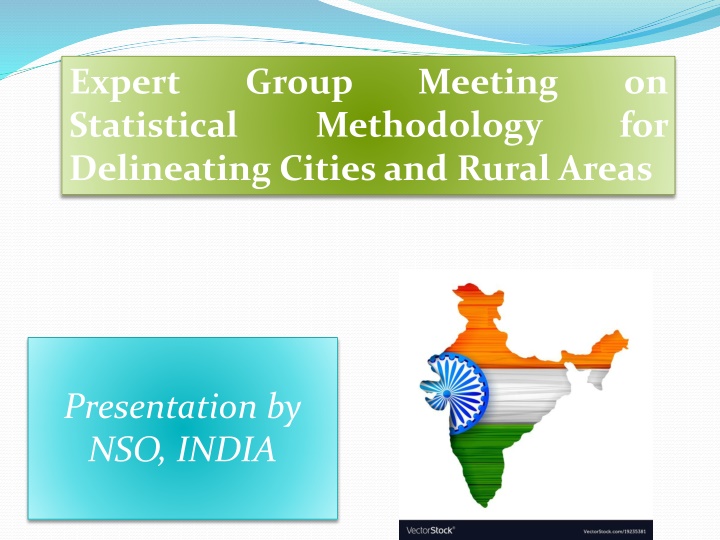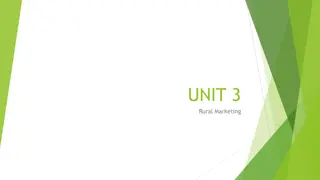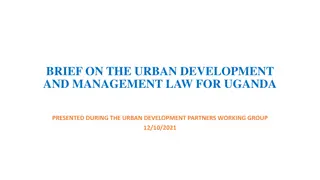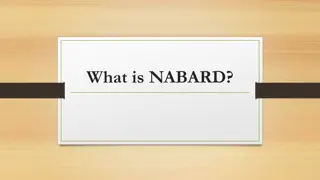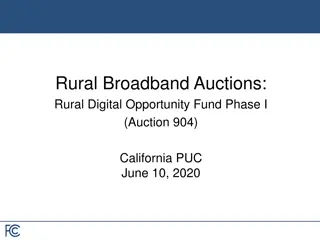Urban and Rural Classification Methodology in India
Expert statistical delineation of cities and rural areas in India, focusing on the definitions and classifications used during the decennial census operations. The process includes identification of urban areas based on population density, economic activities, and other criteria. The concept of Urban Agglomeration (UA) is also explained, highlighting the criteria for defining urban clusters in the Indian context.
Download Presentation

Please find below an Image/Link to download the presentation.
The content on the website is provided AS IS for your information and personal use only. It may not be sold, licensed, or shared on other websites without obtaining consent from the author.If you encounter any issues during the download, it is possible that the publisher has removed the file from their server.
You are allowed to download the files provided on this website for personal or commercial use, subject to the condition that they are used lawfully. All files are the property of their respective owners.
The content on the website is provided AS IS for your information and personal use only. It may not be sold, licensed, or shared on other websites without obtaining consent from the author.
E N D
Presentation Transcript
Expert Statistical Delineating Cities and Rural Areas Group Meeting on for Methodology Presentation by NSO, INDIA
Urban-Rural classifications in India Definitions decennial census operations are followed for producing urban-rural statistics for country and other geographical domains. However, in between two census operations, some new urban areas are also formed and some urban areas may be changed to rural areas. While conducting the surveys during inter census period, the frames are adjusted for these changes. adopted by Census during
Definitions in census URBAN AREA: For the Census of India 2011, the definition of urban area was as follows: All cantonment board or notified town area committee, etc. places with a municipality, corporation, All other places which satisfied the following criteria At least 75 per cent of the male main working population engaged in non-agricultural pursuits; and A density of population of at least 400 persons per sq. km A minimum population of 5,000
Definition in Census The first category of urban units is known as Statutory Towns. These towns are notified under law by the concerned State/UT Government and have local bodies like municipal municipalities, municipal irrespective of their demographic characteristics. corporations, committees, etc., The second category of Towns is known as Census Town.
Definitionin Census City A town with population more than 100,000. Out Growths (OG): An Out Growth (OG) is a viable unit such as a village or a hamlet and clearly identifiable in terms of its boundaries and location. Examples are railway colony, university campus, port area, military camps, etc., which have come up near a statutory town outside its statutory limits but within the limits of a village or villages contiguous to the town. While determining the outgrowth of a town, it has been ensured that it possesses the urban features in terms of infrastructure and amenities such as durable roads, electricity, taps, drainage system for disposal of waste water etc. educational institutions, post offices, medical facilities, banks etc. and physically contiguous with a statutory town.
Definitionin Census Urban Agglomeration (UA): An urban agglomeration is a continuous urban spread constituting a city/town and its adjoining outgrowths (OGs), or two or more physically contiguous towns together with or without OGs of such towns. An Urban Agglomeration must consist of at least a statutory town and its total population (i.e. all the constituents put together) should not be less than 20,000. In varying local conditions, there were similar other combinations which have been treated as urban agglomerations satisfying the basic condition of contiguity. Examples: Greater Mumbai UA, Delhi UA, Kolkata UA, etc.
No. of UAs/Towns and OGs in census 2011 Type of Towns/UAs/OGs Number of towns 1 Statutory Towns 4,041 2 Census Towns 3,892 3 Urban Agglomerations 474 4 Out Growths 981 5 Total number of towns (Statutory + Census) 7933
Population living in urban areas The total urban population in the country as per Census 2011 is more than 377 million constituting 31.16% of the total population. 70% of the total urban population live in the Cities (towns with pop >= 100000) Out of 468 UAs/Towns belonging to Cities, 53 UAs/cities has a population of one million or above each. Known as Million Plus UAs/Cities, these are the major urban centres in the country. 160.7 million persons (or 42.6% of the urban population) live in these Million Plus UAs/Cities. Mega Cities: Among the Million Plus UAs/Cities, there are three very large UAs in the country with more than 10 million persons, known as Mega Cities. These are Greater Mumbai UA (18.4 million), Delhi UA (16.3 million) and Kolkata UA (14.1 million).
Difficulties with the proposed method of degree of urbanisation In the context of India, classification of urban-rural area by urbanisation method is likely to suffer from two aspects: the degree of (i) operational and (ii) conceptual
Operational issues in context of India Network of grid: There is no population grid system for identification of areas. Creation of Population grid by geo-referencing population statistics coming from population registers and population censuses or using contemporary high-resolution satellite imagery and sophisticated algorithms based on land use and land cover information is not possible because such technology is yet to be implemented for large scale operations. Division of areas of the country into grids and collecting statistics on them can only be undertaken during census operations.
Operational issues in context of India Census operations in urban area and Ward / enumeration blocks: Each statutory town in the country has been divided into a number of smaller area units called Wards . They have generally well defined demarcation of boundaries. Wards are political-administrative units within the limits of cities/towns. They have different sizes, infrastructure and population densities, e.g. Wards in the rich localities are generally less dense, have very good infrastructural facilities while wards having slums have congestion, high density, low infrastructure.
Operational issues in urban During census operations, smaller temporary areas are demarcated within each ward. These are called Census Enumeration Blocks (EB). They have typically a population of 600-800 persons. One EB is assigned to an enumerator who collects information for that EB. EBs are not uniform in size and encompasses an area which can be operationally convenient for listing of houses and households.
Operational issues in urban Population density is not enumerated for either ward or EB since area is not enumerated. Ward-wise statistics are disseminated as they are very important while EB-wise statistics are not published. information on population Digitisation of EBs will be attempted during next census (2021) but will be undertaken depending on the resource availability and feasibility in practice.
Operational issues in rural There is no unit called ward within the villages. EBs are formed within a village with the same criteria as urban. Village is temporarily divided into a number of EBs. Each enumerator gathers information for EB assigned to him/her . Statistics are disseminated at village level.
Operationalissues Switching over to grid system will derail the ward or village based information dissemination unless overlapping and synchronisation at certain level is found to be feasible between the two. there is an
Conceptual Issues Comparison between the method followed in the country and the proposed method: Precise comparison cannot be done since no statistics on grid based system is available for the country. In the document (ghsl.jrc.ec.europa.eu) of the European Commission some statistics have been reported for countries. Comparison is done for population of few big Urban Agglomerations.
Comparison of Population of few UAs UA Pop in urban centres as per the document of European Commission Pop as per census 2011 Density per sq.km as per census 2011 New Delhi Kolkata Mumbai Bangalore Chennai Hyderabad Ahmadabad Pune Surat Kozhicode Comparison shows wide divergences in population counts 27,634,561 26,864,480 23,401,888 10,613,010 100,25,644 8,457,883 6,856,946 6,840,466 5,490,339 5,031,610 16,349,831 14,057,991 18,394,912 8,520,435 8,653,521 7,677,018 6,357,693 5,057,709 4,501,610 2,028,399 14,348 13,311 17,297 11,384 9,280 6,264 5,992 10,059 12,660 2,230
Conceptual Issues Within each UAs there are a number of towns besides the core city. For example, in the Kolkata UA, core city is Kolkata but there is also another big city (pop more than a million) and many small towns. Statistics are generated for each city/town separately for administering the policies and programmes. If urbancentre is formed considering the UA, then some of the smaller towns will be merged with city or other towns. How the statistics for individual towns are to be collated ? Some villages are there surrounding the big cities/towns. They have high densities (e.g. there are a number of villages in and around Delhi). Will they be considered as urbancentres or urbanclusters ?
Conceptual Issues Conceptual Issues There are wide variations in the sizes of villages in India. As per the demographic patterns in the villages, people are concentrated in a few clusters even though area of the entire village is large. For big populous villages, the clusters may be dense. Number of villages by size of population can be seen in the next slide.
Number of villages with high population Population range Number of villages Total population % of total rural population of the country 5000-10000 18,492 122,639,952 14.73 10000-20000 3,439 44,554,517 5.35 20000-25000 230 5,112,013 0.61 25000-30000 103 2,778,511 0.33 30000-40000 70 2,394,550 0.29 40000-50000 11 468,758 0.06 >50000 2 1,22,393 0.01 Village population are generally clustered in certain pockets even though area may be large. Many of these pockets may satisfy the criteria of urbancentres or urbanclusters . Will the villages therefore be classified as towns as per the new method ?
We are therefore in a situation where perfect synchronisation is not possible between the methods proposed classifications followed even if the grid system is implemented in future. and the national Current population and demographic statistics are entwined with classifications which cannot be replaced in near future. national system of 21
It is no doubt important to focus on places where human settlements have high population density and take care of basic amenities there. SDG 11 targets cannot be achieved without the assigning priority on these areas. The proposed method will also facilitate comparison among the regions of the world so that monitoring of targets will be easier. 22
On the other hand, countries have short term and long term strategies based on the existing structure of urban-rural delineation. Altering the existing system will have serious implications for the strategies. In India, priority is being given to develop Tier II and Tier III cities so that population pressure on Tier I cities can be controlled. If the contours of these cities are altered in order to conform to the global definition, there will be problems for administering development projects. 23
It is therefore, imperative to explore an alternative where global definition can be embedded into classification system national classification tweaked to suit current global definition. the rather national than 24
